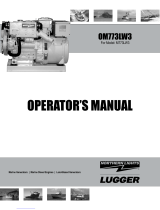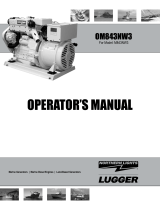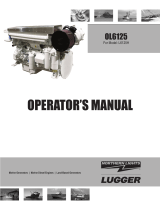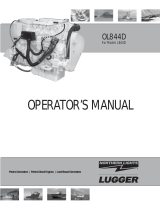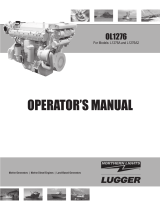
ONL498-2 03/06
17
3. Injector repair and cleaning
a. Take injectors to your Northern Lights dealer or
local injection repair station for testing and service.
4. Injector installation:
a. Place new sleeve in injector hole. Slide injector
into hole or on the injector. replace hold-down
bracket and nuts. Tighten nuts evenly to 18 - 20
ft-lbs. (2.5 - 2.9 kgf-m).
b. Install fuel lines.
c. Install return lines and clamps.
d. Install delivery lines. Leave loose at injectors for
bleeding.
e. Pump hand lever on fuel pump to fill lines.
Tighten lines at injectors. Start engine and check
for leaks using a piece of paper or cardboard.
DO NOT use hand to check for leaks.
SP13. INJECTION PUMP
1. Since operating conditions may vary considerably, it
is difficult to give a definite interval for checking the
injection pump. But as a rule, pump settings,
maximum speed, idle speed and exhaust smoke
should be checked after every 2000 hours of
operation. Service of the fuel injection pump should
only be done if checks indicate pump malfunction.
2. Black smoke can be an indication of pump
malfunction. Before servicing the pump, check other
possible causes:
a. Check cleanliness of air filter.
b. Check valve clearances.
c. Clean and check injectors.
3. Any repair which involves disassembly of the
injection pump must be carried out by specially
trained mechanics with the proper tools and test
equipment.
NOTE: All warranties on the engine become null
and void if the injection pump seals are broken by
unauthorized persons.
COOLING SYSTEM - GENERAL
CAUTION: The cooling water in the engine
reaches extremely high temperatures. You must
use extreme caution when working on hot
engines to avoid burns. Allow the engine to cool
before working on the cooling system. Open the
filler cap carefully, using protective clothing
when the engine is warm.
Servicing
SP14. CHECK THE COOLANT LEVEL
1. Check the coolant level each day before starting the
engine.
a. Check the water level by removing the pressure
cap from the radiator. In order to give the cooling
water an opportunity to expand, the level should be
about 1 in. (2.5 cm) below the filler cap sealing
surface when the engine is cold.
b. The pressure valve in the filler cap releases
when the pressure is approximately 12 PSI
(0.9 kgm/cm
2
). Use a cap pressure tester to check
cap if you suspect it is faulty.
SP15. COOLING SYSTEM FLUSHING
1. Flush the cooling system every 2000 hours or every
12 months, whichever comes first.
2. Remove radiator cap and open drains on radiator and
engine block. The radiator drain is a rubber cap on
the bottom of the radiator. Loosen the hose clamp
and remove the clamp and cap. The hex-headed
engine block drain is on the service side of the
engine below the intake manifold, next to the
flywheel housing.
3. Pour clean water into radiator until water coming
from radiator is clear of discoloration. Close the
radiator drain and continue flushing until water from
engine drain is clear. Open all drains and drain the
engine and radiator completely. Close drains and
refill the radiator with recommended coolant mixture.
4. Use 50% water / 50% ethylene glycol antifreeze
mix. Antifreeze mixture is recommended as a good
year-round coolant.
5. Check hoses and connections and repair any leakage.
6. Start the engine and check for leaks. Run the engine
for five minutes, then shut it down. Let engine cool,
and then check the coolant level in the radiator. Add
coolant as needed.
SP16. CLEAN RADIATOR
1. Remove debris from radiator fins daily.
2. In very dusty applications, clean the radiator with
compressed air or steam cleaner every 100 hours.
Clean in the reverse direction of the airflow.




















